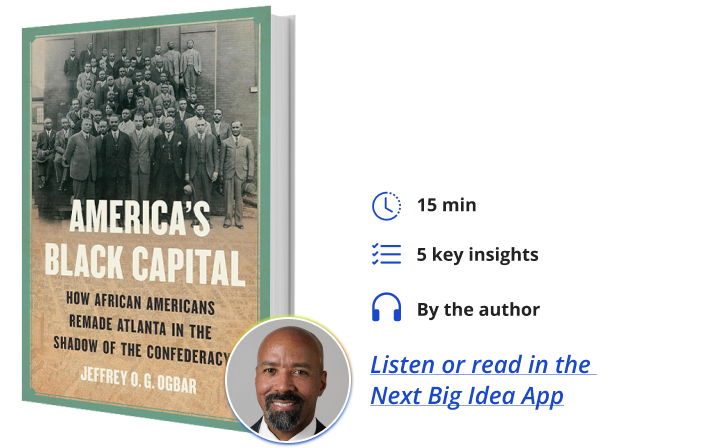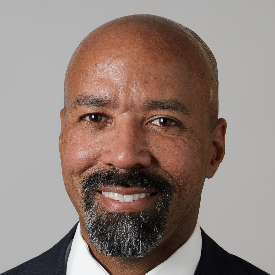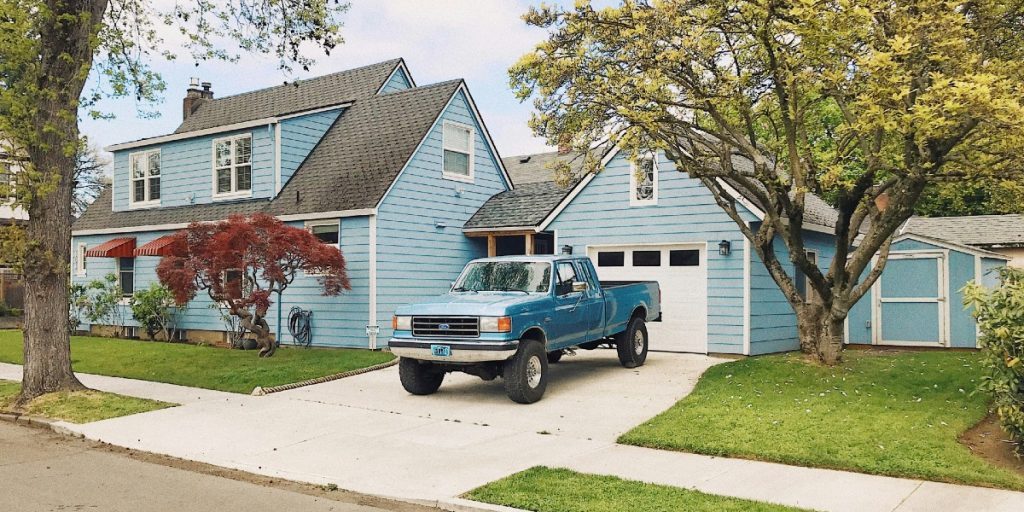Jeffrey Ogbar is Professor of History and the founding Director of the Center for the Study of Popular Music at the University of Connecticut. He is the author or editor of several books, including Black Power: Radical Politics and African American Identity, Hip-Hop Revolution: The Culture and Politics of Rap, and The Harlem Renaissance Revisited: Politics, Arts and Letters. Ogbar received his BA in history from Morehouse College and his MA and Ph.D. degrees in history from Indiana University.
Below, Jeffrey shares five key insights from his new book, America’s Black Capital: How African Americans Remade Atlanta in the Shadow of the Confederacy. Listen to the audio version—read by Jeffrey himself—in the Next Big Idea App.

1. Atlanta was one of the most hardened cities of white nationalism anywhere, and it was central to the outcome of the Civil War.
Antebellum, Georgia, was a very inhospitable place for freedom. Nearly 45 percent of the state was enslaved in 1860, including over 99 percent of its Black population. For the fraction of 1 percent of free blacks, it was illegal for them to be taught to read or write. They had to register with authorities annually and were forbidden from owning firearms. They needed a white guardian to purchase property. They could not purchase an enslaved person, partially to prevent people from surreptitiously freeing people. No one in the state could be freed from slavery, even with the last will and testament, except for a special ruling by the state assembly.
Despite these horrifying, inhuman laws, Atlanta went beyond state law to carve out an even more repressive legislative space against Black people. No free Black people at all were allowed to enter the city of Atlanta unless they registered with authorities. If they failed to do so within five days, they would be arrested and leased out to whites as labor, in effect enslaved. They could not open a business without approval from the city council. They had to secure legal approval to entertain friends. Black social organizations, churches, and schools were all illegal. It was even illegal for Black people to carry canes or wear capes for fear that they might indulge in a sartorial expression beyond their proper station.
It is little surprise that so many Atlantans were eager to join the Confederacy in 1861 when Georgia seceded. While the Confederacy was important to Atlanta, the city was also essential to the rebel government. It was a finalist with Richmond, Virginia, when the rebel government sought a new capital. While they missed the honor of being the capital of the breakaway republic, Atlanta became an essential cog in the Confederate War machine. As one historian notes, by 1863, there was “no greater prize in the Confederacy for military capture than Atlanta.” When Union troops under General Williams Tecumseh Sherman advanced toward the city in the summer of 1864, Georgia Governor Brown pleaded with the Richmond government for support, “We must hold Atlanta. It is to the Confederacy almost as important as the heart is to the human body.” His pleas were in vain, while Sherman laid waste to the gate city in a terrible siege that left the city a desolation.
Americans anxiously followed the fate of the siege. President Lincoln, who was running for reelection, faced grave doubts about his campaign, which witnessed widespread criticism from his own party for his inability to win the war, while his likely democratic opponent proposed Confederate peace, reunification with slavery intact. On August 31st, Lincoln lamented, “I’m a beaten man unless we have some great victory.”
Two days later, he had that victory. Atlanta’s capture in September signaled the collapse of the rebel government. Newspapers in Boston, New York, Philadelphia, and Chicago praised the victory, Sherman, and the commander-in-chief. Lincoln called the military victory famous in the annals of war and was quick to capitalize on the moment. He ordered a 100-gun salute in Washington and a dozen other cities. Two months later, he won reelection in an electoral landslide. After cascading losses, the rebels surrendered in April 1865.
The city of Atlanta was burned to ashes and had lost private and public buildings, homes, hotels, and more. Yet, in the aftermath, a new iteration of the city emerged from the smoldering ruins. With newly freed people pouring into the city, contested visions of the city’s core character emerged and would remain contested for generations to come. No longer illegal, African Americans created churches, social organizations, businesses, and, importantly, schools. These would all form an essential foundation for the gate city of the future, even as it navigated the neo-confederate landscape of the Postbellum period.
2. Atlanta’s essential character has been shaped by the Civil War and the Confederacy.
City leadership and the aftermath of the utter destruction of the city and war found themselves chartering a path to the future that held the fundamentals of the short-lived Confederate identity highly. Atlanta’s fantastic rebirth evinced a resilience greater than the city itself. Atlanta emerged in the late 19th century as a veritable capital of the New South. With a Janus-faced affection for its Confederate past, it also looked to the future for the vantage point of a progressive modern city that was simultaneously prepared for industrial capitalism and full integration to the fabric of American identity. It transitioned from the stultifying occupations of sectional discord and embraced its Americanness, even as it built conspicuous altars and monuments to the Confederacy.
The seal for the city of Atlanta is a testimony to how fundamental the war was to the city. Adopted in 1900, it has two dates: 1847, the year the city was chartered, and 1865, the year the Civil War ended and the city emerged from the ashes of the Union bombardment and destruction. The seal prominently features a mythical phoenix rising from flames with the word “resurgence.”
Over the course of the next few generations, Atlanta, as part of Georgia, would see the rise of redeemers. Those who sought to approximate the Confederate government created white nationalist politics. By the mid-1920s, the KKK had emerged. It emerged in the aftermath of the wildly popular movie Birth of a Nation. In this period, the KKK had an estimated national membership of four million people. Its capital was in Atlanta. The governor of Georgia, Thomas Hardwick, who was elected in 1920, lauded and celebrated the Klan.
“Neo-Confederate nationalism operated unfettered in a way that no other major city had accepted.”
His successor, Clifford Walker, courted and lauded the Klan. An open Klansman, Walter Sims successfully ran for Atlanta Mayor in 1922. The Klan exerted power and influence throughout the state, but the capital city was nearly sacred. In addition to all the Atlanta politicians, police officers, and random men and women who paid Klan membership, the group welcomed all sorts of people into the city each year as tourists. Thousands regularly took a Klan pilgrimage to the Imperial City. Klan revelers paid registration fees, packed hotels and restaurants, and attended sessions on how to protect white supremacy through “real Americanism.” Not to be satisfied with white-only schools such as Emory, the University of Georgia, or Georgia Tech, the Klan attempted to create its own school when a local college went defunct. Emperor Simmons then dreamed of founding his Klan university to teach the principles of 100 percent Americanism.
Atlanta was a throne upon which the head of the congregation surveyed and preached to his flock. Georgia, one historian explains, was the tabernacle of the Klan. The fact that the Klan was so deeply embedded in law enforcement and every other facet of white Atlanta reflected the city’s importance to the organization. The city was the Imperial City, but as one historian insists, it was also the Klan’s holy city. It was a shining example of a modern industrial location under Klan control. Neo-Confederate nationalism operated unfettered in a way that no other major city had accepted. The symbolic value of Klan control in the capital of the New South underscored the importance of its presence. It was this landscape of neo-Confederate control that reflected the marginalization of African Americans socially, economically, politically, and otherwise. As a consequence, African Americans had to rely on themselves in ways few cities demanded or required. This will be significant to the rise of the Black Mecca.
3. The improbable rise of Atlanta’s Black leadership class was a direct consequence of the city’s confederate legacies.
By the 1920s, there emerged a new movement called by many names by historians. The most prominent one is the Harlem Renaissance, also known as the New Negro Renaissance. It was characterized by an explosive expression of African American art, intellectual work, activism, as well as physical movement. During the first wave of the great migration, hundreds of thousands of African Americans left the South for northern cities and cities in the West. Many concentrated in large cities like Philadelphia, New York, and Chicago. In these cities and enclaves of Black enterprise, all sorts of institutions emerged, including a new expression of African American confidence and defiance, a departure from previous iterations of Black identity. Therefore, the New Negro.
By the 1920s, all major Black communities across the country had the same kind of Black institutions, churches, large and small businesses, including barbershops, grocery stores, mortuaries, and medical and dental offices. Many had weekly newspapers. Several cities—New Orleans, Nashville, Washington, and Baltimore—had colleges and universities, but Atlanta was a bit different.
Throughout the 1920s, the reputation of Atlanta drew national meetings of several Black organizations: the National Negro Insurance Association, the NAACP, and fraternities such as Phi Beta Sigma, Omega Psi Phi, and Alpha Phi Alpha at the National Medical Association. Not only did professionals from across the country spend money in the city, but they must have marveled at what African Americans had accomplished. Especially in the business area, the examples were notable. On Auburn Avenue alone, there were more than 70 Black-owned businesses. Atlanta had popular Black chroniclers of the period that gave life to the city. Black-owned photo studios in the area documented weddings, graduations, family portraits, and the beautiful range of Black social life—smiling children, teasing teens, and proud parents.
Also in this historical moment, parents sent their children to be educated at the many colleges and universities for Black people in the city. It had the highest concentration of such schools found anywhere in the country. African Americans were struggling with housing restrictions everywhere in the country, including in Atlanta, where they were excluded from the new suburban homes that were just elbowing their way outside of the city. But in Atlanta, Black developers carved out the first newly constructed suburban housing opportunities for African Americans. In 1926, Joyland Park, a Black suburban housing development, was constructed in the vicinity of the new Black amusement park of the same name. The development boasted homes on high rolling ground and an attractive lay for homes and families. The Atlanta Constitution reported that “the better class of colored people are flocking to Joyland Park.” Though most homes were relatively modest, these were respites from the noise and dirt of the city, drawing people with prices and mortgages accessible to lower-middle-class families. Plans included a clubhouse, a pool, and a grove of beautiful shade trees.
Most Black Atlantans, of course, did not live in opulence or affluence. Most were poor, and they lived in dilapidated housing. They experienced incredible restrictions in educational, political, and every other space one can imagine. By the end of the 1920s, the Black community there, like those communities everywhere, had begun to experience the economic challenges of the Great Depression. Although most Black people in the city were already poor, the conditions became desperate as many people were laid off from low-paying jobs. Members of the community who owned small businesses often struggled. By the mid-1940s, the white primary, which had excluded African Americans from voting, was ruled unconstitutional. This moment ushered in a new period of political expression and activism with African Americans in the city of Atlanta.
Under pressure in 1948, the city of Atlanta hired the first collection of Black police officers. While the Black community was very excited, they had no power to arrest white suspects, even if they saw the white suspects committing an offense against white people. They had to do what everyone else did: call the police. By the next decade, African American leadership, struggling to find new housing opportunities, initiated Project X through the Atlanta Urban League. This was a project to secure housing for African American families. It ultimately became the largest brand new, upscale suburban housing development for Black people anywhere in the United States of America in Collier Heights.
“Even among those cities with numerically larger Black populations, none had exceeded the concentration of Black businesses, newspapers, banking, and higher education than Atlanta.”
By the following decade, as the civil rights movement took form, Atlanta’s own native son, Dr. Martin Luther King Jr, who graduated from Morehouse College, found himself the putative leader of this new modern movement for justice and freedom. The organization he led and co-founded, the Southern Christian Leadership Conference, was founded in 1957 in the city of Atlanta and was headquartered there. The Student Nonviolent Coordinating Committee also found its headquarters in Atlanta. In every way, Atlanta ranks as the center of the New Negro Renaissance. Only one major city in the United States of America, Birmingham, had a higher ratio of Black people in 1920.
Even among those cities with numerically larger Black populations, none had exceeded the concentration of Black businesses, newspapers, banking, and higher education than Atlanta. Many members of nationally prominent African American leadership were based in or recently lived in the city by the 1950s and ’60s. It was a beacon for the New Negro Renaissance and the Black Freedom Movement in conspicuous ways, leading to the ambitious decades to follow.
4. Maynard Jackson, the first Black mayor of the City of Atlanta, became a model of public policy for cities, states, and federal government through his aggressive affirmative action programs known as the Atlanta Plan.
Maynard Jackson would be transformative, not just for the City of Atlanta, but for large parts of the country and beyond.
In 1971, the nation’s largest Black-oriented lifestyle magazine, Ebony, covered Atlanta, among other southern cities, in an issue on Black quality of life in the South. The magazine declared Atlanta was the Black mecca because “Black folks have more, live better, accomplish more, and deal with white folks more effectively than anywhere else in the South or North.” The article praised the Afro self-determinist style that distinguished the Gate City, the massive consortium of Black institutions of higher education, Black businesses, rich Black civic and social organizations, Black religious leadership, and even the expanse of Black middle-class neighborhoods that were built, developed, financed, and occupied by African Americans.
Evidently, Atlanta is not ready for integrated housing, the magazine quipped, even as it measured all these points of praise. The article noted the rise of publicly elected officials such as State Senator Leroy Johnson, Atlanta Board of Education member Benjamin Elijah Mays, and the “big and bold 33-year-old Vice Mayor, Maynard H. Jackson Jr.” who served as the president of the 19-member Board of Aldermen.
The magazine also mentions several business leaders, including Norris B. Herndon, President of the Atlanta Life Insurance Company. Herndon had inherited his business from his father, Alonzo, who was enslaved as a child. In 1971, Norris was worth an estimated $131 million in today’s currency, making him, according to the magazine, the richest Black person in the country. In a country where people of color had been denied access to quality housing, employment, and, until recently, the vote, these stories displayed social, political, and economic Black excellence.
The celebration came as the city was roughly 51 percent Black. Though one of the country’s few predominantly Black major cities, Atlanta offered little in the way of real Black political power. In addition to a white mayor, 15 of the 19 members of the city council were white. Whites represented the overwhelming majority of leadership positions in municipal and county governments. The disproportionately white police force under its white leadership had integrated its patrols only two years earlier. Two-thirds of the 160,000 Atlantans in poverty were Black. Adoring nods to the Confederacy were ubiquitous. Streets, schools, and neighborhoods were named after virulent white supremacists, terrorists, and enslavers, even in the Black communities of every class strata.
The article copiously praised Black businesses in the city, touting, among other things, the Black-owned insurance companies and the new 12-story office building erected by a Black-owned bank. But still, the portion of the city’s contracts to Black firms was about the same as it had been during slavery, less than one percent.
In the arena of popular culture, Atlanta was firmly anchored in old South tropes of genteel enslavers, civilized southern belles, joyful slaves and grinning Negroes. Huge swaths of Black people languish in shanty-like homes and pressing poverty with dismal rates of high school completion.
How could a city with so few examples of political, economic, or cultural power be regarded as a country’s veritable Black city on a hill? Much of this can be explained by the historical moment. Only a handful of major cities had Black mayors in 1971. No city with a sizable Black population had a police force with Black officers at parity with the city’s Black demographics. African Americans were, for the first time in U.S. history, entering a decade where most were not enslaved, in poverty, legally constricted from voting, living in certain neighborhoods, or denied public accommodations.
In historical context, Atlanta, even though deeply flawed by the legacies of racial subjugation, had achieved a considerable amount of success. Additionally, the article was released at the height of the Black Power movement, which had an indelible effect on how Black people feed themselves and their relationship with white people.
Maynard Jackson was elected mayor in 1973 and surprised the country. The new mayor initiated an aggressive affirmative action program to open up city coffers beyond the exclusive use of white businesses. By the time he left office in 1982, the proportion of Black business participation in city contracts went from less than one percent to 40 percent. This became a model for scores of cities across the United States that sought an aggressive expansion of opportunities for Black constituents. Importantly, Mayor Jackson created a new Bureau of Cultural Affairs to situate Atlanta beyond the tropes of the old South. This, too, would pay dividends in future years to come.
5. Atlanta has become the country’s veritable Black capital.
In 1988, nearly 50 years after the debut of Gone With the Wind, the Fulton County Arts Council and the Fulton County Commission, under the leadership of Morehouse alumnus Michael Lomax, founded the National Black Arts Festival. Twenty-two years later, after drawing millions to the city through annual festivals, the United States Congress recognized the festival for its importance to the cultural fabric of greater Atlanta and of all of America. Artists across the spectrum of creativity transformed the city into an extravaganza of Black expression.
Participants included Maya Angelou, Wynton Marsalis, Bill T. Jones, Nikki Giovanni, and Gregory Porter. The festival hosted plays at the 14th Street Playhouse in Midtown. It had jazz, modern dance, ballet, African dance, and blues concerts. It included arts and crafts in Piedmont Park. The festival has been one of dozens of events that have promoted the city’s Black mecca authenticity.
“Atlanta has consistently reflected a level of black executive leadership rarely seen in cities anywhere.”
Additionally, between 1980 and 2020, no city in the country would draw more African-American transplants than Atlanta and its metro area. The cultural, political, social, and economic landscape had been transformed.
Music emerged as one of the most visible artistic forms to emanate from the city. Alternatively called the Motown of the South or the Music Capital of the South, the city became a center of musical production—especially in R&B and hip hop, generating over half a billion in revenues per year. The presence of Gladys Knight, Outkast, Toni Braxton, TLC, Usher, Goodie Mob, Ludacris, TI, Future, 2 Chainz, 21 Savage, Migos, and many more means that Atlanta’s impact on music has been profound across genres.
The Bureau of Cultural Affairs, founded under Maynard Jackson, was paying dividends to the future. In 2016, no other U.S. city had as many TV projects in film work outside of Los Angeles and New York City. Georgia Television and movie production, which grossed more than $9.5 billion for the state, is centered in metro Atlanta, which established the mayor’s office of film and entertainment. Like most Atlanta municipal governments, the office is under black executive management. In fact, two black women currently serve as co-managers of the office.
Atlanta has consistently reflected a level of black executive leadership rarely seen in cities anywhere. One of the largest film production studios in the country is based in Atlanta and is owned by a black billionaire. Because of TV shows or films such as Being Mary Jane, Surviving The Pole, Black Ink Atlanta, Real Housewives Atlanta, Married to Medicine, and ATL, the brand of Atlanta has become so conspicuous to an extent that in 2016, the immensely talented auteur Donald Glover, an area native, launched one of the most critically acclaimed TV shows, aptly named Atlanta.
Despite the many successes that one can chart under Black administrative control, the city has also struggled to make significant progress on reducing Black poverty, even as Black affluence has increased. For a decade, census data have shown that among cities of more than a hundred thousand people, Atlanta has the largest gap between poor and wealthy in the country. Poverty has been persistent in the city, though it is much lower than it is in the surrounding suburbs.
What is conspicuous is that when the wealth gap is measured among U.S. metropolitan areas, including both the city and the suburbs, Atlanta plummets from the top spot of inequality to number 227 on the list. It is far better than dozens of American cities, including Houston, which is 117, and New York, which is 39.
Atlanta’s metropolitan area includes huge swaths of Black upscale subdivisions and integrated neighborhoods stretching across over 20 counties, where African Americans represent a larger raw number than any metro area except New York City. So here lies the increasingly abstract notion of what Atlanta is. Yes, it has the highest concentration of Black millionaires and Black-owned businesses. African Americans are overrepresented in every strata of the city government. Its Black community is so vast that there’s a large home for any segment. A conservative Christian could find a large community of kindred churchgoers and some of the largest Black megachurches anywhere. Simultaneously, exotic dancers have a robust community in what was once the strip club capital of the country.
The city has Black upscale housing developments ringing the city in all parts south, west, east, and now north. It also has swaths of depressed, impoverished Black communities with dilapidated housing. There are robust Black communities of vegetarians, skiers, runners, gun aficionados, and other large Black communities of barbecue fans, bourbon lovers, writers, and artists of every corner of creative expression. You can find gospel in the R&B artists and shared studio space with the grimiest of rappers.
I’ve always wanted someone to tell that story of a Black Atlanta beyond the academic narrative of municipal politics. But when considering the large community that lives outside the city limits, we’re confronted with the increasingly abstract notion of Atlanta. What does it mean to be Atlanta, the capital of the New South? The Imperial City to the Ku Klux Klan, the city too busy to hate, or the Black mecca. Herein lies, again, the abstract notion, and it’s much more than the 136 square miles of the municipality.
For most people, moving to Atlanta means moving to its metropolitan area, where there are literally hundreds of towns and larger communities. The people are drawn to the promises of success and opportunity. Hence, the Black mecca is more capacious than the half-million people living in the core of this sprawling urban abstraction. Suburban success stories, business stories, and creative artistic stories prevail. But the city, though making notable strides, still struggles in its own way.
To listen to the audio version read by author Jeffrey Ogbar, download the Next Big Idea App today:































